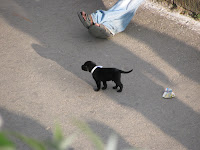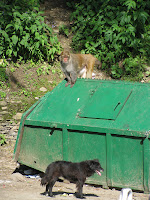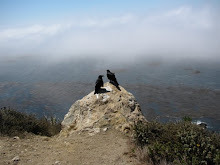The Hindus in India just finished celebrating a nine-day festival called
Navarathri ("nine nights"). The days are marked by late night processions with lots of singing, drumming, and the blowing of conch shells. It all ends with
Dussehra, which commemorates the story of the
Ramayan, when Lord Ram rescued his wife Sita from the clutches of the demon Ravan (with a help of his brother Lakshman, the god Hanuman, and an army of bears, monkeys, vultures, and
Vanar princes) and when effigies of Ravan, his brother, and his son are burned to celebrate Ram’s success.
There was a big festival at Jakhu planned for Dussehra. Earlier in the week, we watched men building the demon effigies. They started by lashing together bamboo poles for the skeletons, which was followed by layers of newspaper and fabric. It reminded me of the Guy that is burned on Guy Fawkes Day in England or what I imagine they burn at Burning Man – times three.

Dussehra was yesterday, and we set out for the festivities after lunch. We were planning to take a taxi up the hill, instead of doing the hike, but trying to catch a cab was madness. Like many things in India, getting into a queue is a nice idea that doesn’t actually fulfill its function. We stood in line, waiting for the taxis to arrive. When one finally appeared, the people formerly in a line immediately surged forward, pushing and shoving to get in (while the original passengers were still trying to get out!), regardless of who had been there first. As you can see in the photo below, people are practically coming out of the windows – and still more are trying to get in the rear door. When this taxi went by, I saw that girls were sitting on each others’ laps, squished in like sardines. After waiting for forty-five minutes and deciding we didn’t want to have to fight anyone to get into a car, we decided to make the hike up after all.

There were more people than usual taking the path up to the temple. On an average day, there might be a young honeymooning couple or two, some aunties in saris, a few older gentlemen in sweater vests, a handful of teenagers in hip Western clothing and students in their school uniforms, and the odd Western tourist either going up or down the road. On festival day, there were hundreds: whole families in their very best saris and
salwar kameez suits and button-down shirts, packs of young dudes, tourists in backpacks and brandishing cameras, and even some stray dogs from Shimla town who didn’t typically go up the hill. Even though Danny had brought his monkey stick, we didn’t really need it: the monkeys seemed too overwhelmed by the sheer number of humans to bother anybody.
Periodically along the path were vendors selling all sorts of festival day goodies. Normally, there is just a Tibetan woman selling shawls (I bought a couple really pretty ones from her last week) and a couple different people selling prasad, including an older woman I call Auntie Prasad, who pushes her wares on everyone who passes by (Rs. 20 for four packets of the white candy – and take two sets, because there are two temples), knits in the meantime, and talks to Danny in Hindi about monkeys and marriage and how she’d like to see me wearing a salwar kameez. None of the usual folks were there, though. Instead, there were people selling plastic flowers,
bhel puri (fried puffs of dough that are, as Danny says, “filled with sickness”), and pillow cases with portraits of tigers on them. As we got closer to the temple, the path became lined with vendors selling a variety of street food (including
pakora,
jalebi, sandwiches of little fried patties, neon-colored cotton candy, and melting
kulfi), as well as all kinds of toys for the children.
There were your typical dolls, toy cars and trucks, pop guns, and other assortment of cheap, plastic junk. For the festival, they were also selling Hanuman masks and the various weaponry used to defeat Ravan and his gang: the bows and arrows of Ram and Lakshman, the club of Hanuman, and swords, all covered in bright, shiny paper. Among the festival toys were masks of Krish, “India’s first superhero,” and Spiderman – just in case, I suppose, you preferred to dress up as something more secular.


The entryway to the temple grounds were decorated in silver and gold tinsel, hanging above our heads. The prasad sellers were out in full force, though there was not a monkey to be seen. We arrived just as the chief minister (similar to a governor back in the States) of Himachal Pradesh was leaving the Shiva temple to go up to the Hanuman temple. There were police officers everywhere because of this, more than I’d ever seen in one place at one time. After Danny bought some prasad from some vendors he knew, we headed up, too, and tried to find a good place to watch the festivities. There were people everywhere: crammed along the edge of the hill, crowded around the outside the temple itself, even up on the scaffolding where normally people were renovating some of the buildings. Danny estimated that there were probably nearly 3,000 people gathered to watch Ravan burn. We ended up standing on the edge of a planter box full of marigolds and barbed wire (to keep out the monkeys). Fortunately, the barbed wire they use around Shimla is fairly harmless; it doesn’t even stop the monkeys.

Ravan and his demon compatriots were set up at the bottom of the first slope beneath the temple (which I thought was a bad set-up, since everyone was above, trying to look down, and still having their views blocked by everyone standing in front of them). The effigies were pink-skinned, with curling mustaches, crowns, and swords. Ravan came complete with his ten heads. At one point, the cast of the Ramayan walked down into the gully where the effigies stood, though what they did after that is a mystery to me, since I couldn’t see down that far. Meanwhile, people were burning huge sparklers and setting off fireworks, which all went off with loud and sometimes disconcerting bangs.


I have to admit that I was a little nervous about three paper-and-bamboo demons being burned in the middle of a pine forest, but they’d done this before and all of the two firemen present would most certainly assure the safety of the trees. I can’t even imagine what would happen if a forest fire broke out with a crowd of thousands present. Crowds in India are not well known for their level-headedness in an emergency. In fact, last year at the Naina Devi temple, about 160 km from Shimla, "162 people died when they were crushed, trampled, or forced over the side of a ravine by the movement of a large panicking crowd" (
Wikipedia). It seems to be part of the culture to push and shove when trying to get to where you’re going. (Danny says, “You can probably find any number of stampede deaths in India if you just search on the internet for five minutes.”)
Finally, the big moment arrived when it was time for the burn. The chief minister, sitting safely up by the temple, started the burn by remote control. He pushed a button or flipped a switch or whatever, and Ravan’s face began to spew fireworks (as depicted in the first photo below). Other fireworks in the bodies of the effigies went off with several loud bangs, and they all caught fire. The crowd cheered and took photos with their cell phones. The air was soon filled with even more smoke, and bits of burning paper were blown into the nearby trees (though, fortunately, without incident). After mostly going up in flames, Ravan toppled to the ground, to the triumphant cheers of the crowd. His companions fell shortly thereafter, fireworks bursting in the sky all the while.


Once that was over, the same crowd that had just swarmed in not an hour before began to swarm back out. As the sea of people thinned, we were able to get closer to where the effigies had been. There were still many people watching the prone bodies burn away – and there were still firecrackers going off in the base of dirt where Ravan had once stood. Suddenly, the small crowd gathered along the hillside rushed the fallen demons and began tearing them apart. Danny asked a fellow standing nearby what was going on, and we were told that the sticks used to create the effigies were “good wood” and therefore good luck. So I said we should get some for ourselves.

We clambered down the hill, into the smoke and the still-exploding fireworks, passing boys and old aunties going back up with handfuls of charred sticks. Another Indian bloke encouraged us to collect some of the wood, explaining that we would “have no fear.” It took some effort to break off a piece or two of bamboo, because the effigies were roped together quite well. On our way back up, I found a piece of demon cheek: one side painted pink and black, the other just regular old newspaper. We later turned to see boys carrying entire parts of rope-tied bamboo skeleton – essentially whole chunks of demon torso.
The evening was capped off by a stop at the café of one of Danny’s informants, where we gorged on way too much (free) bread
pakora, as well as pakora of the potato, eggplant, and pumpkin varieties. We then went to the Hanuman mandir, which by this point was not as busy. I’d never been in before and was nervous about doing something “wrong.” We took off our shoes before climbing the steps into the temple. Inside was a
pandit, seated before the shiny red-orange image of Hanuman. (Danny describes him as a “rock with googly eyes.”) We knelt down, along with a handful of other worshipers. The pandit started by handing out a round of blessed prasad (the typical hazelnuts and white candy), which I missed because I was trying to figure out what was going on. He painted our foreheads with a
tilik of orange paint, then poured us handfuls of rosewater (which Danny warned me after the fact not to drink too much of, though, luckily, I suppose, I accidentally spilled a lot of it). Then Danny walked me around the room, showing me the depictions of scenes from the Ramayan. On the way out the door, I rang one of the temple bells, as people tend to do when visiting the mandir.
Our last stop was to the other café to watch a man making fresh
jalebi. One of Danny’s friends was working, and he gave us some free “samples” of jalebi – which was almost too much on top of the other fried foods we’d eaten. Jalebi is deep-fried batter, almost like a small funnel cake, which is then coated in sticky sweet syrup. They’re especially good when eaten hot, right out of the pan.
By then, it was well after dark, and we made the long trek back down, to recover in our hotel room with beers and TV.



















































